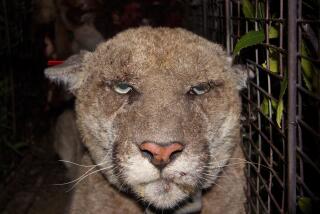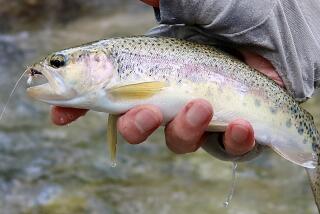Exotic Plant a Growing Problem : Arundo: Biologists are trying to figure out how to control a bamboo-like plant that seemingly can’t be killed. It is threatening the habitats of two endangered species.
Call it the plant from hell.
Arundo, a tall bamboo-like exotic plant, is creating environmental chaos in the quiet canyons of Angeles National Forest and spreading in Ventura County’s Los Padres National Forest.
The stubbornly resilient arundo--which can grow to a height of 25 feet--clogs streams and muscles out native plants. Birds won’t nest in it and, apparently, nothing will eat it. Fire and drought won’t kill it. And if it is chopped down, it grows right back.
“I’m sure a swarm of locusts wouldn’t hurt it,” said Shawna Joyce, a wildlife biologist with the U.S. Forest Service, as she recently surveyed a grove of arundo in the Angeles forest.
Yellowed by winter, the arundo--which was brought to the United States from Morocco years ago to control erosion--looks like a field of giant wheat filling a ravine in San Francisquito Canyon above the Santa Clarita Valley. The slender shafts tower above willows and cattails and surround the trunks of cottonwood trees, leaving only the branches visible.
Worried Forest Service officials are studying ways--including the use of herbicides--to get rid of the pesky plant, which is endangering the habitat of two endangered species.
“It has gone just hog-wild,” said Joyce, who is heading the arundo project.
The work of Joyce and her team is being watched closely by rangers in the Los Padres forest, who fear arundo may overrun native plants, particularly near Matilija Creek northwest of Ojai. “It’s creeping up into the forest,” said Maeton Freel, a forest biologist in Los Padres.
The situation in Ventura County is not as grave as the one in Santa Clarita. Yet, Freel said, Los Padres officials may be forced to consider an eradication program because of the spread of the “giant reed plant,” as arundo also is known.
Freel said biologists are particularly concerned about the least Bell’s vireo, an endangered songbird that prefers shrubs and bushes that the arundo has a habit of displacing. “Our concern is we would lose the habitat and have it replaced by the giant reed,” Freel said.
Tall stalks of arundo can be spotted from San Francisco to San Diego along roads, beside streams and in flood-control channels.
The most successful assault on arundo was developed by biologists in San Diego County, who discovered that by cutting the stalks to a height of about a foot and then spraying or painting them with herbicide, growth could be controlled.
But even this method has drawbacks, said John Rieger, a biologist working to keep Caltrans projects free of arundo in San Diego.
Work crews must apply the poison within five minutes of cutting the stalk because the arundo quickly seals the wound with a protective layer. What’s more, this method only works in the fall, arundo’s prime growing season.
“It’s an extremely durable plant,” Rieger said. “Burning won’t kill it. We’ve tried that.”
In fact, fire helps arundo spread. The giant reed sprouts back to life almost immediately after a blaze and dominates the landscape before native shrubs, bushes and trees can re-establish themselves, Joyce said.
That has been the case near Matilija Creek in Ventura County, where arundo has proliferated since a brush fire wiped out competing plants in 1985, Freel said. “It’s really choked out a lot of stuff,” he said.
Although thick arundo groves may weaken existing trees and shrubs, they probably won’t kill them, Rieger said. But the arundo, which grows into a thick canopy that blocks out the sun, will prevent the next generation of trees and shrubs from growing, he said.
Arundo also is slowly destroying the habitat of some animals.
In the Angeles National Forest, arundo mainly grows in and along stream beds that are the habitat of the least Bell’s vireo and the unarmored three-spine stickleback, a tiny endangered fish.
The fish needs running water, but thick blocks of arundo form miniature dams, causing the water to stagnate, Joyce said. The vireo prefers stream beds lined with a mixture of shrubs, bushes and trees. When arundo takes over, the stream bed is covered with a green blanket through which the birds can’t fly.
The persistent plant can form large bamboo-like walls that block stream access for deer, coyotes and other large animals.
The Forest Service is accepting comments from the public on its proposed three-year eradication program. If plant poison is used, it probably will be Rodeo, an herbicide for aquatic areas that is approved by the federal Environmental Protection Agency. The agency lists Rodeo as nontoxic to fish and animals, Joyce said.
Rieger, who has successfully used Rodeo on the giant reed in San Diego, said most biologists generally avoid using poisons to control exotic species. But this plant, he said, leaves biologists with few other choices.
“This is one area where a controlled use of chemical herbicide is justified,” he said.
Joyce said she hopes to develop an eradication plan by fall. By then, of course, the arundo will have grown a little taller and spread farther.
As she recently drove along San Francisquito Canyon Road, Joyce recalled the roadside mailbox of one of the canyon’s many ranches. The arundo had grown so dense that the mailbox could hardly be seen. The rancher finally whacked off the plant’s stalk.
A few months later, she said, the arundo was once again standing tall, and the mailbox was hidden from view.






